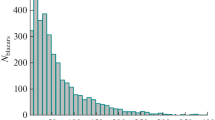Abstract
The “blazar sequence” posits that the most powerful BL Lacertae objects and flat-spectrum radio quasars should have relatively small synchrotron peak frequencies, ν peak, and that the least powerful such objects should have the highest ν peak values. This would have strong implications for our understanding of jet formation and physics and the possible detection of powerful, moderately high-redshift TeV blazars. I review the validity of the blazar sequence by using the results of very recent surveys and compare its detailed predictions against observational data. I find that the blazar sequence in its simplest form is ruled out. However, powerful flat-spectrum radio quasars appear not to reach the ν peak typical of BL Lacs. This could indeed be related to some sort of sequence, although it cannot be excluded that it is instead due to a selection effect.
Similar content being viewed by others
References
Antón, S., Browne, I.W.A.: The recognition of blazars and the blazar spectral sequence. Mon. Not. Roy. Astron. Soc. 356, 225–231 (2005)
Caccianiga, A., Marchã, M.J.M.: The CLASS blazar survey: testing the blazar sequence. Mon. Not. Roy. Astron. Soc. 348, 937–954 (2004)
Collinge, M.J., et al.: Optically identified BL Lacertae objects from the Sloan Digital Sky Survey. Astron. J. 129, 2542–2561 (2005)
Costamante, L., et al.: A low density of the extragalactic background light revealed by the HESS spectra of the BL Lac objects 1ES 1101-232 and H 2356-309. Astrophys. Space Sci., doi: 10.1007/s10509-007-9418-7 (2007)
Fossati, G., Celotti, A., Ghisellini, G., Maraschi, L.: Unifying models for X-ray-selected and radio-selected BL Lac objects. Mon. Not. Roy. Astron. Soc. 289, 136–150 (1997)
Fossati, G., Maraschi, L., Celotti, A., Comastri, A., Ghisellini, G.: A unifying view of the spectral energy distributions of blazars. Mon. Not. Roy. Astron. Soc. 299, 433–448 (1998)
Ghisellini, G.: Private communication (2003)
Ghisellini, G., Celotti, A., Fossati, G., Maraschi, L., Comastri, A.: A theoretical unifying scheme for gamma-ray bright blazars. Mon. Not. Roy. Astron. Soc. 301, 451–468 (1998)
Giommi, P., Padovani, P.: BL Lacertae reunification. Mon. Not. Roy. Astron. Soc. 268, L51 (1994)
Giommi, P., Menna, M.T., Padovani, P.: The sedentary multifrequency survey—I. Statistical identification and cosmological properties of high-energy peaked BL Lacs. Mon. Not. Roy. Astron. Soc. 310, 465–475 (1999)
Giommi, P., Piranomonte, S., Perri, M., Padovani, P.: The sedentary survey of extreme high energy peaked BL Lacs. Astron. Astrophys. 434, 385–396 (2005)
Giommi, P., et al.: ROXA J081009.9+384757.0: a 1047 erg/s blazar with hard X-ray synchrotron peak or a new type of radio-loud AGN. Astron. Astrophys. (2007, in press). arXiv: astro-ph/0703491
Giommi, P., Colafrancesco, S., Cavazzuti, E., Perri, M., Pittori, C.: Non-thermal cosmic backgrounds from blazars: the contribution to the CMB, X-ray and γ-ray backgrounds. Astron. Astrophys. 445, 843–855 (2006)
Landt, H., Padovani, P., Perlman, E.S., Giommi, P., Bignall, H., Tzioumis, A.: The Deep X-Ray Radio Blazar Survey (DXRBS)—II. New identifications. Mon. Not. Roy. Astron. Soc. 323, 757–784 (2001)
Landt, H., Perlman, E.S., Padovani, P.: VLA Observations of a new population of blazars. Astrophys. J. 637, 183–199 (2006)
Landt, H., Padovani, P., Perlman, E.S., Giommi, P., Perri, M., Cheung, C.C.: A search for synchrotron X-ray emission from radio quasars. In preparation (2007)
Mazin, D.: Observations of extragalactic sources with the MAGIC telescope—TeV blazars and extragalactic background light. Astrophys. Space Sci., doi: 10.1007/s10509-007-9440-9 (2007)
Nieppola, E., Tornikoski, M., Valtaoja, E.: Spectral energy distributions of a large sample of BL Lacertae objects. Astron. Astrophys. 445, 441–450 (2006)
Padovani, P., Giommi, P.: The connection between X-ray- and radio-selected BL Lacertae objects. Astrophys. J. 444, 567–581 (1995)
Padovani, P., Giommi, P., Fiore, F.: A multifrequency database of active galactic nuclei. Memorie della Societá Astronomica Italiana 68, 147–148 (1997)
Padovani, P., Costamante, L., Giommi, P., Ghisellini, G., Comastri, A., Wolter, A., Maraschi, L., Tagliaferri, G., Megan Urry, C.: BeppoSAX observations of 1-Jy BL Lacertae objects—I. Mon. Not. Roy. Astron. Soc. 328, 931–943 (2001)
Padovani, P., Costamante, L., Ghisellini, G., Giommi, P., Perlman, E.: BeppoSAX observations of synchrotron X-ray emission from radio quasars. Astrophys. J. 581, 895–911 (2002)
Padovani, P., Perlman, E., Landt, H., Giommi, P., Perri, M.: What types of jets does Nature make? A new population of radio-quasars. Astrophys. J. 588, 128–142 (2003)
Padovani, P., Costamante, L., Giommi, P., Ghisellini, G., Celotti, A., Wolter, A.: BeppoSAX observations of 1-Jy BL Lacertae objects—II. Mon. Not. Roy. Astron. Soc. 347, 1282–1293 (2004)
Padovani, P., Giommi, P., Landt, H., Perlman, E.: The Deep X-ray Radio Blazar Survey (DXRBS). III. Radio number counts, evolutionary properties, and luminosity function of blazars. Astrophys. J. (2007, in press). arXiv: astro-ph/0702740
Perlman, E.S., Padovani, P., Giommi, P., Sambruna, R., Jones, L.R., Tzioumis, A., Reynolds, J.: The deep X-ray radio blazar survey. I. Methods and first results. Astron. J. 115, 1253–1294 (1998)
Pian, E., et al.: BeppoSAX observations of unprecedented synchrotron activity in the BL lacertae object Markarian 501. Astrophys. J. 492, L17 (1998)
Urry, C.M., Padovani, P.: Unified schemes for radio-loud active Galactic nuclei. Publ. Astron. Soc. Pac. 107, 803–845 (1995)
Veron-Cetty, M.-P., Veron, P.: A Catalogue of Quasars and Active Nuclei, 9th ed. ESO Scientific Report, vol. 19 (2000)
Wolter, A., et al.: BeppoSAX spectral survey of soft X-ray selected BL Lacertae objects. Astron. Astrophys. 335, 899–911 (1998)
Author information
Authors and Affiliations
Corresponding author
Rights and permissions
About this article
Cite this article
Padovani, P. The blazar sequence: validity and predictions. Astrophys Space Sci 309, 63–71 (2007). https://doi.org/10.1007/s10509-007-9455-2
Received:
Accepted:
Published:
Issue Date:
DOI: https://doi.org/10.1007/s10509-007-9455-2




